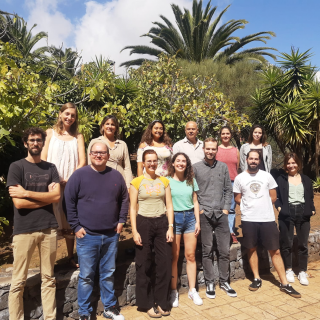Bibcode
Spriggs, T. W.; Sarzi, M.; Napiwotzki, R.; Galán-de Anta, P. M.; Viaene, S.; Nedelchev, B.; Coccato, L.; Corsini, E. M.; de Zeeuw, P. T.; Falcón-Barroso, J.; Gadotti, D. A.; Iodice, E.; Lyubenova, M.; Martín-Navarro, I.; McDermid, R. M.; Pinna, F.; van de Ven, G.; Zhu, L.
Referencia bibliográfica
Astronomy and Astrophysics
Fecha de publicación:
5
2020
Revista
Número de citas
23
Número de citas referidas
15
Descripción
Extragalactic planetary nebulae (PNe) are detectable through relatively strong nebulous [O III] emission and act as direct probes into the local stellar population. Because they have an apparently universal invariant magnitude cut-off, PNe are also considered to be a remarkable standard candle for distance estimation. Through detecting PNe within the galaxies, we aim to connect the relative abundances of PNe to the properties of their host galaxy stellar population. By removing the stellar background components from FCC 167 and FCC 219, we aim to produce PN luminosity functions (PNLF) of these galaxies, and thereby also estimate the distance modulus to these two systems. Finally, we test the reliability and robustness of our novel detection and analysis method. It detects unresolved point sources by their [O III] 5007 Å emission within regions that have previously been unexplored. We model the [O III] emissions in the spatial and spectral dimensions together, as afforded to us by the Multi Unit Spectroscopic Explorer, and we draw on data gathered as part of the Fornax3D survey. For each source, we inspect the properties of the nebular emission lines to remove other sources that might hinder the safe construction of the PNLF, such as supernova remnants and H II regions. As a further step, we characterise any potential limitations and draw conclusions about the reliability of our modelling approach through a set of simulations. By applying this novel detection and modelling approach to integral field unit observations, we report for the distance estimates and luminosity-specific PNe frequency values for the two galaxies. Furthermore, we include an overview of source contamination, galaxy differences, and possible effects on the PNe populations in the dense stellar environments.
Tables 4 and 5 are only available at the CDS via anonymous ftp to http://cdsarc.u-strasbg.fr (ftp://130.79.128.5) or via http://cdsarc.u-strasbg.fr/viz-bin/cat/J/A+A/637/A62
Proyectos relacionados

Huellas de la Formación de las Galaxias: Poblaciones estelares, Dinámica y Morfología
Bienvenida a la página web del g rupo de investigación Traces of Galaxy Formation. Somos un grupo de investigación amplio, diverso y muy activo cuyo objetivo principal es entender la formación de galaxias en el Universo de una manera lo más completa posible. Con el estudio detellado de las poblaciones estelares como bandera, estamos constantemente
Anna
Ferré Mateu